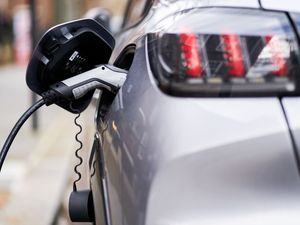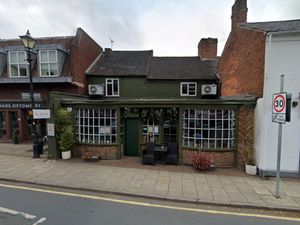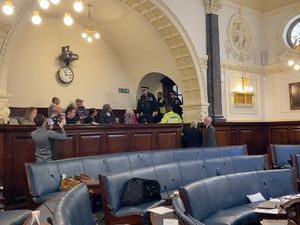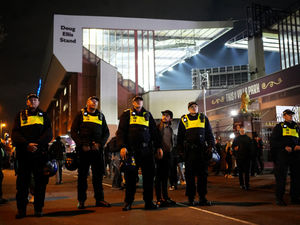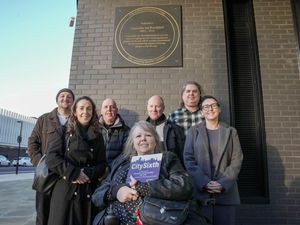Tom Watson demands probe into claims British troops were used in nuclear experiments
Tom Watson has called on the Defence Secretary to apologise over the death of a British serviceman whose family say was used as a 'guinea pig' for nuclear bomb testing.
Labour's deputy leader has demanded a full investigation into 'radiation experiments' on British troops during the height of the Cold War between 1952 and 1967.
It comes after the widow of former RAF pilot Eric Denson said she had obtaining secret documents that show her husband was used in a deadly experiment as he was ordered to fly through the cloud of a thermonuclear explosion.
Shirley Denson, 83, said he was exposed to such a massive dose of radiation to his head in the 1958 flight that it caused crippling headaches so bad that he later killed himself due to the intolerable pain.
The Ministry of Defence (MoD) has denied the claims and said it was wrong to suggest British troops were the subject of a nuclear experiment.
West Bromwich East MP Mr Watson, who is campaigning for nuclear test veterans to be given medals, said: "This is a shocking document and its contents are something the MoD cannot wriggle out of.
"We need answers about how many other experiments were conducted, and how many of the 22,000 nuke test vets were involved in them.
"The Defence Secretary should come to the House of Commons and issue an unqualified apology for what happened to Eric Denson and explain what he is doing to find out just how far this went."
As a result of the hydrogen bomb, two of the Densons' four daughters were born with abnormalities as were some grandchildren and great-grandchildren, it has been reported.
The papers show Mr Denson, who was 24 at the time, had his head exposed to 65 years’ worth of normal background radiation – the same as 17,500 dental X-rays – during just six minutes spent flying through the cloud at Christmas Island in the South Pacific.
Mrs Denson said of the documents: “It’s absolutely wicked. It’s evil. To see it in black and white after all these years took my breath away. It seems our Government used and abused its own men.
“It makes me furious to think it was done on purpose, that my Eric mattered so little to them.”
British Nuclear Test Veterans’ Association chairman Alan Owen said: “This is the first time in all our years of campaigning we have ever found evidence this strong.
“Our members always believed they were guinea pigs and this appears to prove some of them were, at best, collateral damage in horrifying experiments. We need to know everything – now.”
The bomb, codenamed Operation Grapple Y, was the most deadly weapon Britain has ever fired and was 140 times more powerful than the blast that destroyed Hiroshima.
A spokesperson for the MoD said: “It is not true to say these men were subject to an experiment to look at the effects of radiation.
“The British nuclear testing programme contributed towards keeping our country secure during the Cold War and regular health checks were conducted throughout.
“The National Radiological Protection Board has carried out three studies of nuclear test veterans and found no valid evidence to link this programme to ill health.”
Mrs Denson, of Morden, south London, was handed the papers by the MoD during research about her husband's service.
Mr Denson flew his converted Canberra B6 bomber into the mushroom cloud of a 2.8 megaton nuclear explosion on April 28, with X-ray badges on his seat to measure radiation.
They were placed behind the head, on both arm rests, and in the seat pan for each member of the aircrew.
The papers, which were seen by The Mirror, said ‘care was taken to ensure as little shielding effect as possible’ was given to the badges – and thus the crew.
Immediately after the tests, Mr Denson suffered vomiting and a rash, common symptoms of radiation poisoning.
But according to reports, within 48 hours he was ordered to fly the plane again.
Veteran Joe Pasquini, who was a navigator in the same squadron, has a copy of Mr Denson’s pilot logbook which shows he returned to the air in the same plane on May 30 for a 75-minute ‘radar calibration and formation’ flight.
The paper – written by scientists running the tests – states those who received a dose of radiation between 10 Roentgen and 25 must not be exposed again for three years.
Mr Denson’s dose was 18.8R, meaning he should have been protected.
One of the badges was placed near his groin. It recorded a dose of 8.8R, or around 30 years' worth of normal background radiation.
The document added: “Testicular badges: The very significantly lower levels are of interest and cheer in relation to the possibility of genetic damage.”
Mr Denson killed himself in 1976.

